英语专业论文outline模板
- 格式:wps
- 大小:23.00 KB
- 文档页数:2
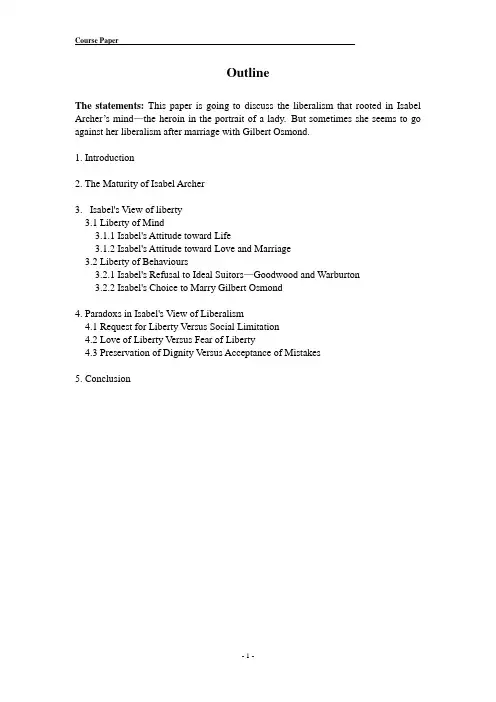
OutlineThe statements: This paper is going to discuss the liberalism that rooted in Isabel Archer’s mind—the heroin in the portrait of a lady.But sometimes she seems to go against her liberalism after marriage with Gilbert Osmond.1. Introduction2. The Maturity of Isabel Archer3.Isabel's View of liberty3.1 Liberty of Mind3.1.1 Isabel's Attitude toward Life3.1.2 Isabel's Attitude toward Love and Marriage3.2 Liberty of Behaviours3.2.1 Isabel's Refusal to Ideal Suitors—Goodwood and Warburton3.2.2 Isabel's Choice to Marry Gilbert Osmond4. Paradoxs in Isabel's View of Liberalism4.1 Request for Liberty Versus Social Limitation4.2 Love of Liberty Versus Fear of Liberty4.3 Preservation of Dignity Versus Acceptance of Mistakes5. ConclusionLiberalism of Isabel Archer in The Portrait of a LadyAbstract: abel Archer, the heroine of The Portrait of a Lady, a brilliant female figure in the world's literary gallery, is a controversial figure . The thesis focuses on the analysis of Isabel Archer view of liberty and paradoxes in her liberalism in order to explore that her arrogance and blindness lead to her tragedy marriage. Then I will further illustrate her attitude toward life, love and marriage. Later analyzing her liberalism in details by presenting her mind and behaviors aims at discovering her inner thoughts. At last, I will dissect three paradoxes in Isabel’s view of liberalism—her own requests against social limitations, love against fear and preservation of dignity against acceptance of mistake . The causes lead her betray mind are herself mostly and her arbitrary husband partly.Key Words: Henry James; paradoxes; liberalism;atitude分析《贵妇画像》中伊丽莎白˙阿切尔的自由主义观摘要: 莎白˙阿切尔,《贵妇画像》这部小说的女主人公,是享誉全球文艺画廊的一位出色的女性形象,同时她也一个具有争议性的人物。
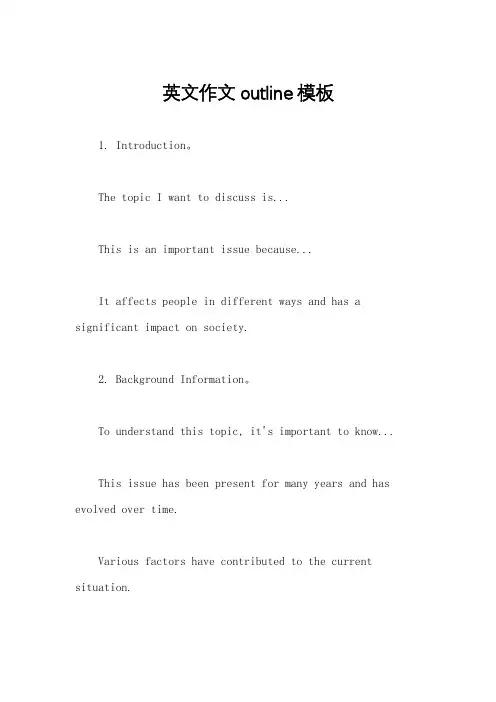
英文作文outline模板1. Introduction。
The topic I want to discuss is...This is an important issue because...It affects people in different ways and has a significant impact on society.2. Background Information。
To understand this topic, it's important to know...This issue has been present for many years and has evolved over time.Various factors have contributed to the current situation.3. Personal Experience。
I have personally experienced this issue when...It made me realize the importance of addressing this problem.Many people can relate to this experience and understand its significance.4. Statistics and Data。
Research shows that...The numbers speak for themselves and highlight the severity of the issue.It's important to consider these statistics when discussing potential solutions.5. Challenges and Obstacles。
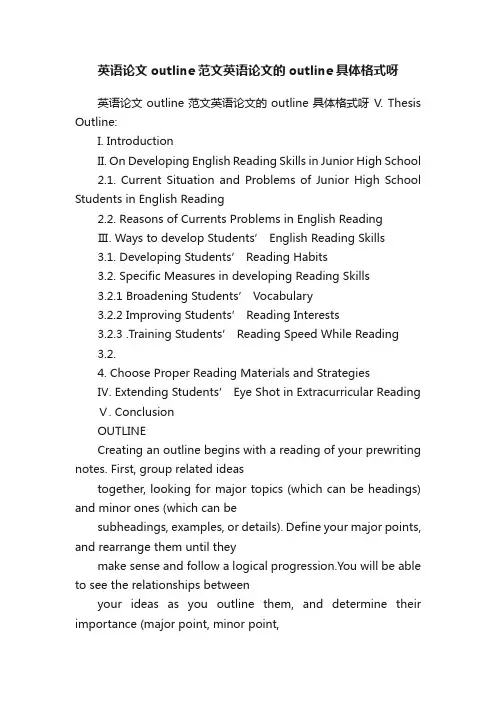
英语论文outline范文英语论文的outline具体格式呀英语论文outline范文英语论文的outline具体格式呀V. Thesis Outline:I. IntroductionII. On Developing English Reading Skills in Junior High School2.1. Current Situation and Problems of Junior High School Students in English Reading2.2. Reasons of Currents Problems in English ReadingⅢ. Ways to develop Students’ English Reading Skills3.1. Developing Students’ Reading Habits3.2. Specific Measures in developing Reading Skills3.2.1 Broadening Students’ Vocabulary3.2.2 Improving Students’ Reading Interests3.2.3 .Training Students’ Reading Speed While Reading3.2.4. Choose Proper Reading Materials and StrategiesⅣ. Extending Students’ Eye Shot in Extracurricular Reading Ⅴ. ConclusionOUTLINECreating an outline begins with a reading of your prewriting notes. First, group related ideastogether, looking for major topics (which can be headings) and minor ones (which can besubheadings, examples, or details). Define your major points, and rearrange them until theymake sense and follow a logical progression.You will be able to see the relationships betweenyour ideas as you outline them, and determine their importance (major point, minor point,example, detail). If you need more supporting details or facts—subcategories—you can addthem now. As you outline your information, use one-word topics, short phrases, or writeout full sentences for each point on your outline.If your prewriting notes are somewhat organized, you can use the outlining feature includedin most word-processing programs to create an outline. Otherwise, arrange them yourself ina standard outline form using Roman and Arabic numerals and upper and lower case letters:I.A.B.1.2.a.b.Once you have pleted an outline, revise and refine it by following these steps:1. Write down your overall goal for your essay.What are you trying to say to yourreaders?2. Go over your outline and circle, underline, or highlight your major points orimages. Do they all support your goal?3. Brainstorm words and phrases that will aurately and concisely express thosepoints (jot them down in the margin of your outline, or use a separate sheet ofpaper).4. Use this list and your outline to guide your writing. Do not allow yourself tostray from your goal or your major points.Outline:I. IntroductionII.A.B.C.D.E.F. III.A.B.C.IV. ConclusionThen her charming smile, that smile make me feel warm. Especially in the winter. That smile are like what freesia.Winter is the season that leaves, but mon in cold season flowering, which will undoubtedly give the wholewinter has brought angry. And she's like Freesia, her smile brought a glimmer of warmth to the winterseason;there is no exception in the light of the sun, when the evening sunset, in the west to emit light, shining on every corner of the school, at that moment, she es back, she smiles, that unforgettable smile, this is simply a words can not describe the 'beauty'There is a One's childish dispos很高兴为您解答O(∩_∩)O~满意请及时【采纳】 ^_^1。
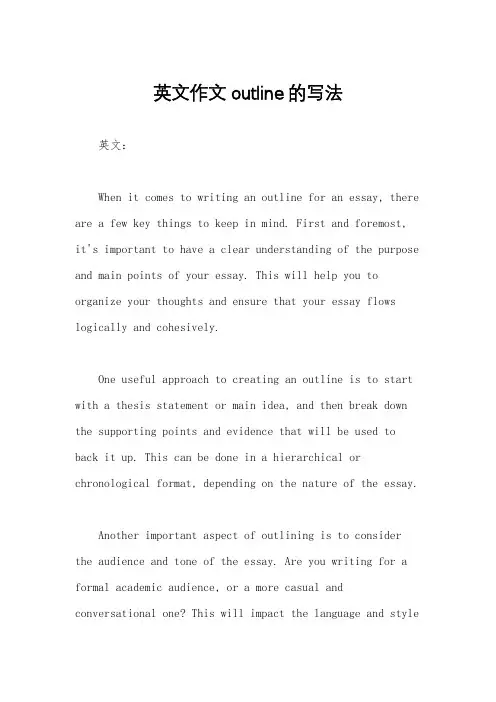
英文作文outline的写法英文:When it comes to writing an outline for an essay, there are a few key things to keep in mind. First and foremost,it's important to have a clear understanding of the purpose and main points of your essay. This will help you to organize your thoughts and ensure that your essay flows logically and cohesively.One useful approach to creating an outline is to start with a thesis statement or main idea, and then break down the supporting points and evidence that will be used to back it up. This can be done in a hierarchical or chronological format, depending on the nature of the essay.Another important aspect of outlining is to consider the audience and tone of the essay. Are you writing for a formal academic audience, or a more casual and conversational one? This will impact the language and styleof your outline, as well as the types of examples and evidence you choose to include.Ultimately, the key to a successful outline is to be flexible and open to revision. As you begin to flesh out your ideas and write your essay, you may find that certain points need to be added, removed, or reorganized. By starting with a clear and well-organized outline, however, you'll be better equipped to handle these changes and produce a polished final product.中文:写作大纲是一篇文章的重要组成部分,需要注意几个关键点。
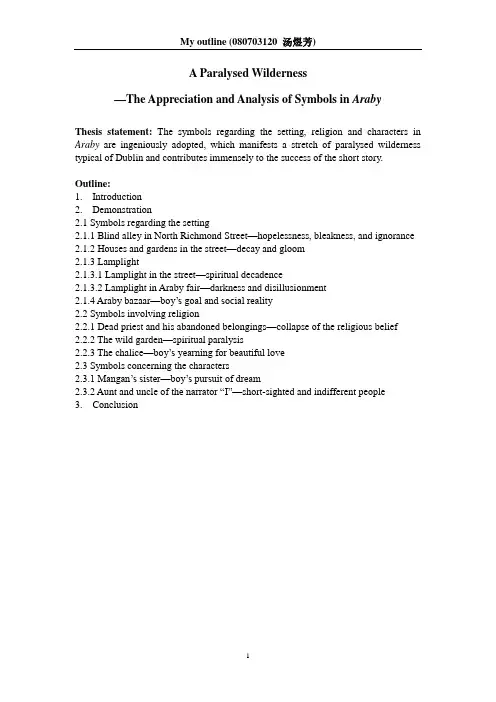
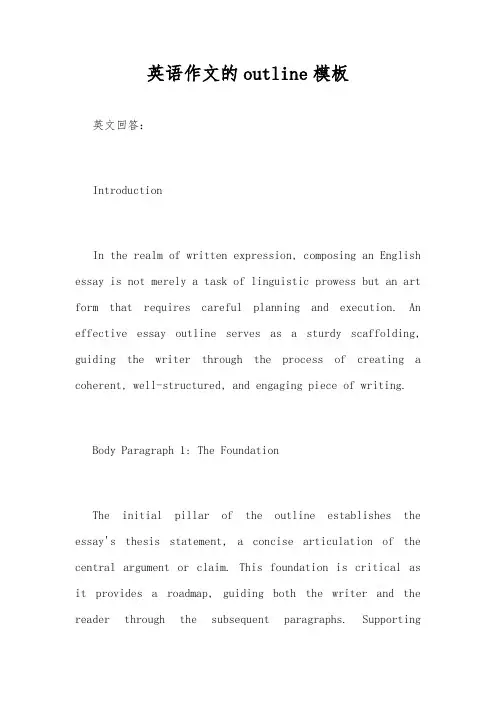
英语作文的outline模板英文回答:IntroductionIn the realm of written expression, composing an English essay is not merely a task of linguistic prowess but an art form that requires careful planning and execution. An effective essay outline serves as a sturdy scaffolding, guiding the writer through the process of creating a coherent, well-structured, and engaging piece of writing.Body Paragraph 1: The FoundationThe initial pillar of the outline establishes the essay's thesis statement, a concise articulation of the central argument or claim. This foundation is critical as it provides a roadmap, guiding both the writer and the reader through the subsequent paragraphs. Supportingevidence, drawn from credible sources or personal anecdotes, anchors the thesis statement, bolstering its credibility and laying the groundwork for the essay's development.Body Paragraph 2: Exploration and AnalysisThe second paragraph delves into the first major point that supports the thesis statement. Here, the writer explores the topic in greater depth, utilizing a variety of perspectives and angles to strengthen the argument. Engaging the reader on an intellectual level, the writer analyzes and discusses the implications of the supporting evidence, building momentum towards the essay's climax.Body Paragraph 3: Expansion and ComplexityThe third paragraph extends the essay's argument by introducing a second major supporting point. This paragraph allows the writer to expand the scope of the discussion, introducing new perspectives or exploring the topic'scomplexities. It serves as a bridge, seamlessly connecting the initial point to the upcoming conclusion.Body Paragraph 4: Transition and ReinforcementThe fourth paragraph transitions smoothly between the two major supporting points. It reinforces the overall argument, weaving together the threads of the preceding paragraphs to create a cohesive narrative. Through the skillful use of transitional devices, the writer maintains the flow of the essay, guiding the reader's understanding effortlessly.ConclusionIn the concluding paragraph, the writer brings the essay to a satisfying close. The thesis statement is revisited, reinforced, and expanded upon. The writer succinctly restates the main points, leaving a lasting impression on the reader's mind. A final thought, a call to action, or apoignant reflection may serve as a thought-provoking finale, inviting contemplation and engagement long after the essay has been read.中文回答:导言在书面表达领域,写好一篇英语作文不仅仅是语言能力的展示,更是一种需要精心规划和执行的艺术形式。
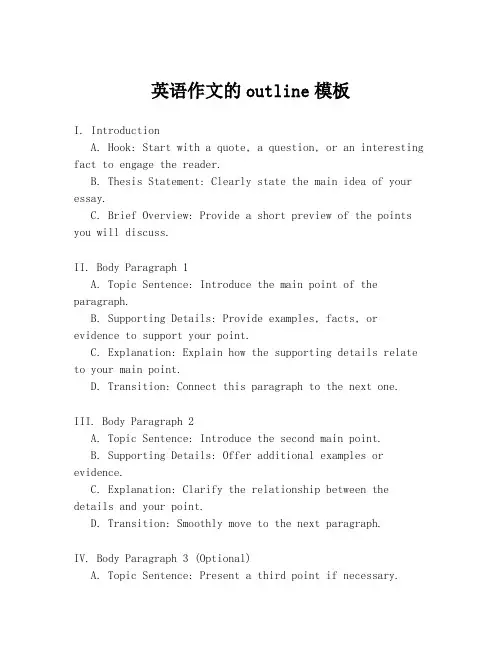
英语作文的outline模板I. IntroductionA. Hook: Start with a quote, a question, or an interesting fact to engage the reader.B. Thesis Statement: Clearly state the main idea of your essay.C. Brief Overview: Provide a short preview of the points you will discuss.II. Body Paragraph 1A. Topic Sentence: Introduce the main point of the paragraph.B. Supporting Details: Provide examples, facts, or evidence to support your point.C. Explanation: Explain how the supporting details relate to your main point.D. Transition: Connect this paragraph to the next one.III. Body Paragraph 2A. Topic Sentence: Introduce the second main point.B. Supporting Details: Offer additional examples or evidence.C. Explanation: Clarify the relationship between the details and your point.D. Transition: Smoothly move to the next paragraph.IV. Body Paragraph 3 (Optional)A. Topic Sentence: Present a third point if necessary.B. Supporting Details: Include relevant examples or facts.C. Explanation: Discuss how these details support your argument.D. Transition: Prepare the reader for the conclusion.V. Counterargument (Optional)A. Acknowledgment: Recognize the opposing viewpoint.B. Refutation: Provide reasons why the opposing view is weaker or less valid.C. Reinforcement: Strengthen your thesis by contrasting it with the counterargument.VI. ConclusionA. Restate Thesis: Reiterate your main idea in a new way.B. Recap Main Points: Summarize the key arguments you made in the body paragraphs.C. Final Thought: End with a call to action, a question, or a thought-provoking statement.VII. Works Cited (if applicable)A. List of Sources: Include all the sources you cited in your essay, formatted according to the required citation style.Remember to keep your outline flexible. As you write, you may find that your ideas develop in new directions, and that's okay. An outline is a guide, not a rigid structure. Adjust your outline as needed to best serve your essay's purpose and your audience's needs.。
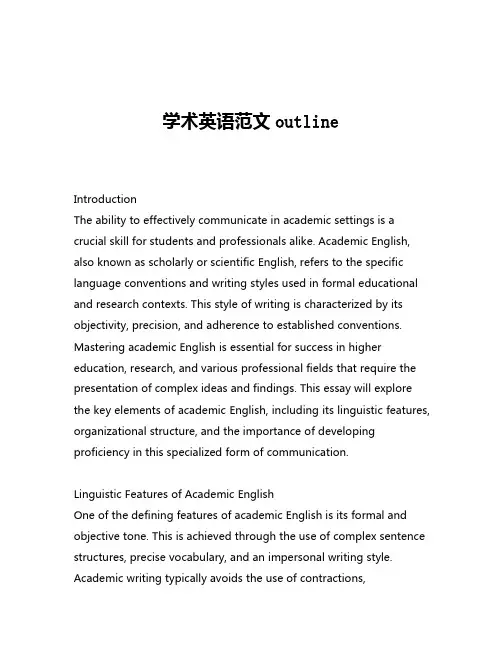
学术英语范文outlineIntroductionThe ability to effectively communicate in academic settings is a crucial skill for students and professionals alike. Academic English, also known as scholarly or scientific English, refers to the specific language conventions and writing styles used in formal educational and research contexts. This style of writing is characterized by its objectivity, precision, and adherence to established conventions. Mastering academic English is essential for success in higher education, research, and various professional fields that require the presentation of complex ideas and findings. This essay will explore the key elements of academic English, including its linguistic features, organizational structure, and the importance of developing proficiency in this specialized form of communication.Linguistic Features of Academic EnglishOne of the defining features of academic English is its formal and objective tone. This is achieved through the use of complex sentence structures, precise vocabulary, and an impersonal writing style. Academic writing typically avoids the use of contractions,colloquialisms, and personal pronouns, instead favoring more formal language choices. For example, a sentence such as "The researchers found that the new treatment was effective" would be preferred over a more casual phrasing like "They found the treatment worked well."Additionally, academic English is characterized by the use of discipline-specific terminology and technical jargon. This specialized vocabulary is essential for accurately conveying complex ideas and concepts within a particular field of study. Researchers and scholars must be able to use these terms correctly and consistently to ensure clear and unambiguous communication with their peers.Another linguistic aspect of academic English is the emphasis on precise and concise language. Academic writers strive to express their ideas clearly and succinctly, avoiding unnecessary wordiness or redundancy. This is achieved through the use of well-structured sentences, logical transitions, and a focus on conveying the key points and findings.Organizational Structure of Academic WritingThe organizational structure of academic writing is another crucial element that distinguishes it from other forms of communication. Academic essays and research papers typically follow a standardized format, which includes an introduction, body, and conclusion. The introduction serves to provide background information, establish thecontext, and clearly state the thesis or main argument. The body of the text then presents the supporting evidence, analysis, and discussion of the topic, often organized into well-defined sections or paragraphs. Finally, the conclusion summarizes the key points, draws logical inferences, and may suggest avenues for further research or exploration.Within this overall structure, academic writers also employ various rhetorical strategies to effectively convey their ideas. These strategies may include the use of definitions, explanations, comparisons, and the integration of relevant sources and citations. The inclusion of in-text citations and a comprehensive reference list is a hallmark of academic writing, as it demonstrates the writer's engagement with the existing scholarly discourse and their ability to properly acknowledge the work of others.Importance of Proficiency in Academic EnglishDeveloping proficiency in academic English is essential for success in higher education and various professional contexts. For students, the ability to write in the academic style is crucial for completing assignments, research papers, and thesis or dissertation projects. Mastering academic English allows students to effectively communicate their ideas, demonstrate their understanding of course material, and engage with scholarly sources in a meaningful way.Beyond the academic realm, proficiency in academic English is also highly valued in many professional fields, such as scientific research, medicine, law, and business. In these contexts, the ability to present complex information, data, and findings in a clear, concise, and well-organized manner is crucial for effective communication with colleagues, clients, and stakeholders. Professionals who can navigate the conventions of academic English are often better equipped to contribute to the knowledge base of their respective fields and participate in the broader scholarly discourse.Moreover, the globalization of education and research has further emphasized the importance of academic English proficiency. With the increasing internationalization of higher education and the growing prominence of English as the lingua franca of academia, the ability to communicate effectively in academic English has become a valuable asset for scholars, researchers, and students from diverse cultural and linguistic backgrounds.ConclusionIn conclusion, academic English is a specialized form of communication that is essential for success in higher education and various professional contexts. Its linguistic features, such as formal tone, precise vocabulary, and complex sentence structures, as well as its standardized organizational structure, set it apart from other forms of written expression. Developing proficiency in academicEnglish is crucial for students and professionals alike, as it enables them to effectively convey complex ideas, engage with scholarly sources, and contribute to the knowledge base of their respective fields. As the global academic landscape continues to evolve, the mastery of academic English will only become more vital for those seeking to thrive in the world of research, education, and professional advancement.。

o u t l i n e范本(总6页)--本页仅作为文档封面,使用时请直接删除即可----内页可以根据需求调整合适字体及大小--OutlineThe statements: This paper is going to discuss the liberalism that rooted in Isabel Archer’s mind—the heroin in the portrait of a lady. But sometimes she seems to go against her liberalism after marriage with Gilbert Osmond.1. Introduction2. The Maturity of Isabel Archer3.Isabel's View of libertyLiberty of MindIsabel's Attitude toward LifeIsabel's Attitude toward Love and MarriageLiberty of BehavioursIsabel's Refusal to Ideal Suitors—Goodwood and WarburtonIsabel's Choice to Marry Gilbert Osmond4. Paradoxs in Isabel's View of LiberalismRequest for Liberty Versus Social LimitationLove of Liberty Versus Fear of LibertyPreservation of Dignity Versus Acceptance of Mistakes5. ConclusionLiberalism of Isabel Archer in The Portrait of a LadyAbstract: abel Archer, the heroine of The Portrait of a Lady, a brilliant female figure in the world's literary gallery, is a controversial figure . The thesis focuses on the analysis of Isabel Archer view of liberty and paradoxes in her liberalism in order to explore that her arrogance and blindness lead to her tragedy marriage. Then I will further illustrate her attitude toward life, love and marriage. Later analyzing her liberalism in details by presenting her mind and behaviors aims at discovering her inner thoughts. At last, I will dissect three paradoxes in Isabel’s view of liberalism—her own requests against social limitations, love against fear and preservation of dignity against acceptance of mistake . The causes lead her betray mind are herself mostly and her arbitrary husband partly.Key Words: Henry James; paradoxes; liberalism;atitude分析《贵妇画像》中伊丽莎白˙阿切尔的自由主义观摘要: 莎白˙阿切尔,《贵妇画像》这部小说的女主人公,是享誉全球文艺画廊的一位出色的女性形象,同时她也一个具有争议性的人物。
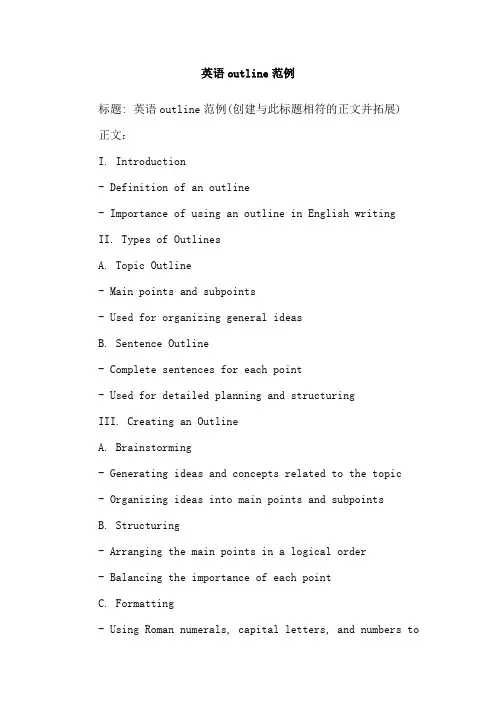
英语outline范例标题: 英语outline范例(创建与此标题相符的正文并拓展)正文:I. Introduction- Definition of an outline- Importance of using an outline in English writingII. Types of OutlinesA. Topic Outline- Main points and subpoints- Used for organizing general ideasB. Sentence Outline- Complete sentences for each point- Used for detailed planning and structuringIII. Creating an OutlineA. Brainstorming- Generating ideas and concepts related to the topic- Organizing ideas into main points and subpointsB. Structuring- Arranging the main points in a logical order- Balancing the importance of each pointC. Formatting- Using Roman numerals, capital letters, and numbers toindicate hierarchy- Ensuring consistent formatting throughout the outline IV. Expanding the OutlineA. Adding Supporting Details- Including evidence, examples, and statistics to substantiate each point- Providing additional information to strengthen the argumentB. Developing Subpoints- Elaborating on subpoints to provide more in-depth analysis- Using transitional words and phrases to connect ideas C. Revising and Editing- Evaluating the outline for coherence and clarity- Making necessary revisions and edits to improve the structure and flowV. Conclusion- Recap of the importance of using an outline in English writing- Encouragement to use outlines as a tool for effective organization and communication拓展:1. Benefits of Using an Outline:- Helps to organize thoughts and ideas coherently- Provides a clear structure and logical flow to the writing - Saves time by preventing unnecessary reorganization during the writing process2. Common Mistakes to Avoid in Creating an Outline:- Overcomplicating the outline with too many levels of subpoints- Failing to balance the importance of each point, resulting in an unbalanced argument- Neglecting to include supporting details and evidence for each point3. Techniques for Expanding the Outline:- Conducting research to find relevant sources and evidence - Including personal experiences or anecdotes to add depth to the argument- Using quotes from experts or authoritative figures to strengthen the credibility of the writing4. Tips for Revising and Editing the Outline:- Ensuring that each point is clear, concise, and directly supports the main topic- Checking for consistency in formatting, such as usingparallelism in headings and subheadings- Seeking feedback from peers or instructors to gain different perspectives on the outline's effectivenessIn conclusion, using an outline is an essential tool for effective English writing. By creating a well-structured outline and expanding it with supporting details, writers can enhance the coherence and clarity of their writing. Regularly revising and editing the outline helps to refine the content and ensures a strong argument. Therefore, it is highly recommended to utilize outlines in English writing for better organization and communication.。

英文作文outline格式1. Introduction。
The topic I want to discuss is the impact of social media on teenagers.Social media has become an integral part of teenagers' lives, with its influence extending to their behavior, mental health, and relationships.2. Positive effects。
Social media allows teenagers to connect with friends and family members, regardless of geographical location.It provides a platform for self-expression and creativity, allowing teenagers to share their thoughts, ideas, and talents with a wider audience.3. Negative effects。
Excessive use of social media can lead to addiction and have a negative impact on teenagers' mental health.Cyberbullying and online harassment are prevalent on social media platforms, causing emotional distress and anxiety among teenagers.4. Impact on relationships。
英语作文的outline模板英文回答:Outline Template for English Essay。
I. Introduction。
A. Hook: Start with an interesting fact or quote to grab the reader's attention.B. Background information: Provide some context and background information on the topic.C. Thesis statement: Clearly state the main argument or purpose of the essay.II. Body Paragraphs。
A. Topic sentence: Introduce the main idea of the paragraph.B. Supporting details: Provide evidence, examples, and explanations to support the topic sentence.C. Analysis: Analyze and interpret the evidence to show how it supports the main argument.D. Transition: Use transitional words or phrases to smoothly connect the paragraphs.III. Counterargument。
A. Acknowledge the opposing viewpoint.B. Refute the counterargument with evidence and reasoning.C. Strengthen the original argument by showing its superiority.IV. Conclusion。
英语专业文献综述Outline(5篇)第一篇:英语专业文献综述OutlineOutline 1 Introduction 2 Literature overreview2.1 Peer review2.2 incidental vocabulary acquisition2.3 Peer evaluation and the teacher3 Design of the study4 Results4.1 Students as evaluatees4.2 Students as evaluators5 Discussion6 Conclusion第二篇:英语专业实习报告 intership report outlineOutline for Internship Report1.First PageFirst page should display: Student name and surname, internship start and finish dates, number of internship days, type of internship(production, or design and development), company/institution name.This page should be signed and stamped by the supervisor of the intern student.2.Weekly timetableA weekly timetable where each row in the table corresponding to a day in internship period.Each row should record the date, internship activity on that date.Weekly Schedule should explain the work accomplished each day of the week during the internship period and should contain:•••The department of the organization that the week was and signature of the controlling supervisor for each week The official stamp of the organization.3.A Brief Executive Summary of the InternshipA one page summary of the company/institution and a short account of the major activities carried out during the internship period.4.Table of ContentsContents of the report with page numbers, list of tables, and list of figures.5.Description of the company/institution This section should answer the following questions:5.1.What is the full title of the company/institution? Give a brief history of the company, fullmailing address and relevant web links.5.2.What is the type of ownership of the company/institution? State the main shareholders andtheir shares.5.3.What is the sector that the company/institution operates in? Specify the products and servicesproduced and offered to its customers.5.4.Who are regarded as the customers of your internship company/institution(consider the endusers, retailers, other manufacturers, employees, etc.)?5.5.Provide an organization chart of the company, along with information on the number ofemployees.5.6.Provide a list of functions performed by the mechanical engineers in the internshiporganization.6.Internship activitiesThis is the main body of your report.You should present the activities performed during the internship period.Please refer to “” document for the types of analysis and inquiries that you should be perfo rming during “Production”, and “Design and Development” internship.7.An assessment of the internship In this section you should answer the following questions7.1.What skills and qualifications you think that you havegained from the internship?7.2.What kind of responsibilities you have undertaken during the internship period?7.3.How do you think the internship will influence your future career plans?7.4.How do you think the internship activities that you carried out are correlated with yourclassroom knowledge?8.Conclusions of the reportThis section should include:• A summary of key conclusions derived from the internship experience.• General observations about the sector in which your internship company/institution operates9.Appendices and supplementary material(charts, graphs, pictures, computer codes, etc.)10.ReferencesRules for writing the internship report:••••••You do not have to provide a day-to-day diary of the internship activities.Do not write theoretical excerpts from textbooks!Describe what you exactly did there and what experiences you have gained throughout your training.The internship report should be between 15-20 pages and written to “Training Program Diary” which can be provided from the university bookstore.The internship report should be written in handwriting, and each page should contain about 25 lines.The internship report should be original, no photocopies areaccepted.You can include graphs, pictures, data, drawings, or design calculations in your report;however they should not cover more than 1/3 of the rger graphs, pictures, data, drawings, or design calculations should be given as an Appendix.第三篇:Outline 4Social Movements of the 1960sI.Background---Greensboro Sit-in(格林斯博罗静坐)On February 1, 1960, 4 freshmen from a black college in Greensboro, North Carolina(北卡罗莱纳州), sat down at a department lunch counter and ordered coffee.When refused, they continued to sit at the counter, openly defying the segregation law prevailing in the state.The next day, more students joined them.Thus began the civil rights movement(黑人民权运动), which spread from the south to the ter, this quiet “sit-in” became the major nonviolent direct action tactics to be used by black civil rights activists.*The civil rights movement, and the youth anti-war, and the women’s liberation movements had long roots in United States history.(黑人民权运动、青年反战运动以及后来的妇女解放运动都深深地植根于美国历史之中)II.Definition---One professor argues that “a social movement is a type of behavior in which a large number of participants consciously attempt to change existing institutions and establish a new order of life.”---Two basic characteristics of all social movements: “structure”(有组织)and “spontaneity”(自发性)---Other necessary parts of a social movement are:1.a social base of people 人这一社会基础2.a “message” or ideology 思想体系3.the ability to spread the message and get more supporter 传播思想和得到更多支持者的能力III.The Civil Rights Movement---One of the most important of all social movement in the 1960s U.S.history.Rosa Park’s(罗莎•帕克斯)spontaneous action(自发行为)in 1955 was believed to be the true beginning of the civil rights movement.The black students’ sit-in at a department lunch counter in North Carolina touched off(触发,激起)the nationwide civil rights movement.During the first half of the decade, civil rights organizations like SNCC(the Student Nonviolent Coordinating Committee学生非暴力统一行动委员会), CORE(the Congress of Racial Equality争取种族平等大会), and SCLC(the Southern Christian Leadership Conference南部基督教领导联合会)struggled for racial integration by providing leadership, tactics, network and the people.In the latter half of the decade, some black organizations changed their nonviolent tactics, and emphasized on more radical means to end discrimination and raised the self image of the blacks.The civil rights movement produced such great leaders as Martin Luther King, Jr., and Malcolm X, who inspired a generation of both blacks and whites to devote their lives to fighting for racial equality in the U.S.---Montgomery Bus Boycott蒙哥马利抵制公交车隔离政策运动In December 1995, Rosa Parks, a NAACP(National Association for the Advancement of Colored People(美国)全国有色人种协进会)member in Montgomery Alabama, refused to give up herseat to a white man on a public bus.Alabama law required that blacks sit at the back of the bus, and when asked, surrender their seats to whites.Mrs.Parks was arrested.Local black leadersdecided to boycott the city’s bus system.Black people in th e city spontaneously began to boycott the bus system refusing to ride on public buses.In the year long Montgomery bus boycott, blacks young and old, walked to work.With the bus company near bankruptcy, and the aid of a 1956 Supreme Court decision, Montgomery blacks triumphed.In fact, the boycott was believed to be the true.---Direct Action Tactics直接行动策略When the civil rights movement began, non-violent direct action tactics like “sit-ins” and “freedom rides”(自由乘车运动), voter registration(投票者登记).Later, anti-war activists added “teach-ins” on college campuses,((大学师生举行的)时事宣讲会,讨论会,辩论会)to educate people about the war in Vietnam as well as protest marches and rallies and etc.---Martin Luther King, Jr.Martin Luther King, Jr., an Atlanta-born Baptist minister(浸礼会牧师), was the leader of the Southern Christian Leadership Conference during the civil rights movement of the 1960s.To promote his philosophy of nonviolent protest against segregation and other kinds of social injustice, King organized a series of “marches”, incl uding the March on Washington of August, 1963, when King delivered his famous “I have a Dream” speech.As a civil rights leader, King worked not only to end racial discrimination(种族歧视)0and poverty, but also to raise the self image of the blacks.Due to his strong belief in nonviolent peaceful protest, King was awarded the Nobel Peace Prize in 1964.He was assassinated in the city of Memphis(孟斐斯)in April 1968.---Contrary to King’s nonviolent tactics, Malcom X(马尔科姆•艾克斯)spoke in favour of black separatism(分离主义)and against nonviolence in fighting racial discrimination.---Some of SNCC(学生非暴力统一行动委员会)members thought they needed a strong leader rather than collective leadership.In 1965, theyelected a new chairman, Stokeley Carmichael(斯托克利•卡迈克尔)who spoke about Black Power.*The most notorious terrorist group against black civil rights workers in the South was known as Ku Klux Klan三K党*Those who worked in the civil rights movement included Negro leaders, black and white young people, and some professionals and some housewives.IV.The Youth Movement *Many young people were involved in the social movements of the 1960 because they resented traditional white male values in U.S.society.---Free Speech MovementMario Savio(马里奥•萨维奥), a student who had just returned from working with SNCC in the Mississippi Freedom Summer, took off his shoes and stood on top of the police car.He demandedthat the CORE worker be freed and the rules against free speech be changed.The students sat around the car for 32 hours in spontaneous, nonviolent, direct action.Other students “sat-in” at the administration buildings and organized “Free University” classes.The California governor called hundreds of police to the campus.800 students were arrested.Graduate students organized a strike and closed the university.The teachers and professors voted to change the rule that violate the 1st and 14th Amendments.The young people’s “Free Speech Movement” began with success.---“counter culture”(反主流文化)In the wake of the Free Speech Movement and the New Left appeared a phenomenon that historians called the “counter culture”.The Counter Culture rejected capitalism and other American principles.They had morals different from taught by their parents.Some groups of youth tried to construct different ways of life.Among the most famous were the hippies(嬉皮士).They sought new experience through dropping out, drugs.But it was music, rock music in particular, that became the chief vehicle for the counter cultural assault on traditional American society.The counter culture exerted a great influence upon people’s attitudes toward social mores, marriage, career, and success.---The Anti-War Movement(against the war in Vietnam) V.Women’s Liberation MovementThe women’s movement in the 1960s was started by three groups of women and an accident.---1.a group of professional women who were appointed to a Commission on the Status of Women(妇女地位委员会)by President Kennedy in 1961.---2.white housewives and mothers who read Betty Friedan’s(贝蒂•弗里丹)book, The Feminine Mystique《女性之迷》, published in 1963.---3.young activists(激进主义分子, 行动主义分子)in the civil rights and anti-war movements.NOW((美国)全国妇女组织) ---With the publication of The Feminine Mystique in 1963, Betty Friedan became the chief spokesperson of the Women’s Liberation Movement.In her book, she compared the American family, or the American society as a whole, to a “comfortable concentration camp”, where women were discriminated against and oppressed.In 1966, she helped to found the National Organization for Women(NOW).A reform organization, NOW battle d for “equal rights in partnership with men.”Canada: The Country and its PeopleI.A brief introduction of Canada(the geography, population, culture, economy, languages etc.)1)the 2nd largest country in size with a small population,2)has spectacular scenery of mountains, oceans, forests and prairies3)has a lively and rich culture4)one of the Big Seven(US, UK.Germany, France, Japan, Italy and Canada)in economy;has the best standards of living5)most Canadians live in the south of the country, along the 49th parallels(纬度)6)two official languages: English and French7)first become a political entity(政治实体)in 1867 and did not assume its present shape until 1949(直到1949年才具有目前的规模)(National Day: July 1st)II.The Canadian identity---It refers to something which is distinctively Canadian, which is different from other countries, and which is the very reason for making Canada so special.For example, two official languages of English and French can be considered as part of the Canadian identity.III.The regions of Canada---Motto: Canada stretches “from sea to sea” with the Pacific Ocean along the west coast and the Atlantic Ocean on the east coast---share with the U.S.the longest undefended national border in the world(加拿大和美国共享着世界上最长的不设防国界), a symbol of their good relations---consists of 10 provinces and 3 territories1.The north region of Canada---Canada extends up north into the Arctic Circle(北极圈)to the North pole.The north is a scarcely populated area of ice and oceans,which is sometimes called “the Land of the M idnight Sun”(午夜太阳之地).This region is currently divided into three administrative territories—the Yukon(育空地区), the Northwest Territories and Nunavat(努勒维特地区a territory carved from eastern part of the original Northwest Territories in 1999).And most of the inhabitants are Aboriginal people.The traditionaleconomy in this region was based on hunting and trapping animals for food and pelts, but now oil and gas deposits are also being developed.2.the west(西部1省)---the western-most province is British Columbia(布列颠哥伦比亚省)with 3 major mountain ranges running through it, among which the largest in ke Louise(路易斯湖), located in the Rockies, is the most famous image of the Canadian landscape (加拿大风景最突出的代表).BC is Canada’s 2nd largest producer of hydroelectric power.However, its main economic mainstay(支柱)is its forests.It has the most valuable forestry industry.3.The Prairies(草原3省)---The prairie provinces of Alberta(阿尔伯塔省), Saskatchewan(萨斯喀彻温省)and Manitoba(马尼托巴省)lie east of the Rockies(落基山脉).The prairies are flat and featureless and have a harsh continental climate.They are called the breadbasket(胃, 腹)of Canada because the land is well-suited to farming, and wheat is one of the biggest agricultural crops in this area.The prairies are also rich in energy resources.4.Central Canada(2省)---Central Canada, Ontario(安大略省)and Quebec(魁北克省), are the parts of the country that were first settled.They are the industrial heartland of the country and are also the most densely populated provinces.They have the largest cities like Tor onto in Ontario, and the country’s 2nd largest city Montreal(蒙特利尔)in Quebec.The capital of the country Ottawa is also in Ontario.5.The Maritimes(滨海诸省:4个省)(the Atlantic regions)---The Atlantic provinces of New Brunswick(新不伦瑞克省), Nova Scotia(新斯科省the first part of Canada to be settled in 1604), Prince Edward Island(爱德华太子岛省)andNewfoundland(纽芬兰省the last province to join Canada in 1949)are also known as the Maritimes.They are small in population and largely rely on the fishing industry for their economic wealth.They are rich in farming and forestry products and are quite popular tourist attractions.IV.The history1.the First Nations(the Aboriginal people)---the native Indians with rich cultures and highly developed societies.2.European settlement in Canada---Settlement by European began in the 17th century.French colonists first settled Canada.The earliest major settlements were established in Nova Scotia in 1604 and Quebec in 1608.During earlier settlements, the French set the Company of New France and Britai n founded the Hudson’s Bay Company to facilitate trade.3.In 1867 Canada was born when Quebec, Ontario, New Brunswick and Nova Scotia all join together into a confederation.The Government and Politics of CanadaI.Canada’s political system1.Canada’s politic al system was greatly influenced by the two major foreign forces: Britain and America.2.American ideas influenced the Canadian system to some degree.For example, freedom of speech and freedom of information are much valued in contemporary Canada.So, Canadian society appears to be similar to American society, but they are different.While the US was founded on the idea of individualism---Americans aspire to “life, liberty and the pursuit of happiness”---Canadians chose to found a nation based on “peace, order and good government”.In other words, for Canadians, the well-being and liberty of individuals must sometimes be sacrificed for the greater good of the community.3.Canadian society allows a highdegree of tolerance of different values and customs.4.To find a workable balance between community and individual rights has been the central concern of Canadian policy-makers.5.It attempts to reconcile the two communities of English-speaking Canada and French-speaking Canada.II.Canada’s system of government1.based on the British system of parliamentary democracy, referred to as “Westminster-style” democracy英格兰东南部大伦敦的一个市区,位于泰晤士河岸。
OUTLINE NOTES Thesis statement:Japanese theater rose froma popular to elite and then returned to apopular art form.I.IntroductionII.Early theatrical formsA.BugakuB.SarugakuC.Primitive NohD.Authors and Audience III.Noh theaterA.AuthorsB.Props1.Masksa.womenb.demonsc.old men2.Structure of StageC.Themes1.Buddhist influence2.The supernaturalD.Kyogen interludesE.AudienceIV.KabukiA.AuthorsB.Props1.make-up2.special effectsC.Themes1.Love stories2.RevengeD.AudienceV.Bunraku(puppet)theaterA.AuthorsB.PropsC.Themes1.Love stories2.Historical romancesD.AudienceVI.Conclusion The thesis is stated in the first section,which is the introduction.The body follows the introduction,and breaks down the points the author wishes to make.Note that some section have subdivisions, others do not,depending on the demands of the paper.In this outline,II,III,&IV all have similar structure,but this will not necessarily be true for all papers.Some may only have three major sections,others more than the five given here.Your conclusion should restate your thesis, and never introduce newmaterialVEGETARIANISM: PRO AND CONT h esis statement: Increasing worldwide population and shrinking food supplies suggest that changes in food habits such as vegetarianism may be necessary for the survival of the human species. The advantagesand disadvantages or a vegetarian diet will be considered in this paper.I. There are many advantages to a vegetarian diet.A. Vegetarians ingest less fat and cholesterol and are therefore at less risk for heartdisease.B. Vegetarians eat mostly fresh vegetables and are therefore less likely to ingestcancerous agents such as preservatives.C. Given sufficient space, vegetarians can grow much of their own food, which is bothsafer and cheaper than buying it.D. Vegetarianism causes less damage to the environment.1. Vegetables require less fuel and water than cattle.2. Farmers could produce more food if they did not devote so much farmland tocattle.3. Vegetarians don't kill animals for food.II. There are also some disadvantages to a vegetarian diet.A. Care is needed to avoid protein and vitamin deficiencies.1. Vegetarians may need vitamin supplements.2. Vegetarians are at more risk for anemia than meat eaters.B. Vegetarian diets are not a varied as others.1. A complex combination of recipes is needed to keep the diet interesting.2. It is difficult to get much variety in textures and tastes.C. It is difficult to be a vegetarian in a meat-eating society.1. Vegetarians are often looked upon as cultists.2. Vegetarians are sometimes thought to be self-righteous.Traditional Alpha-NumericFormat I.Main point (or chapter)A.Support to main point 1.Evidence for point IA 2.More evidence for IA B.Second support for main point 1.Evidence for point IB a.support for this evidence b.more support for this evidence 2.More evidence for IB II.Second main point (and so on)Decimal Format1.0.Main point (or introduction to a chapter)1.1.First issue in this chapter 1.1.1.Evidence for point 1.11.1.2.More evidence for 1.11.2.Second issue in this chapter 1.2.1Evidence for point 1.21.2.1.1.support for this evidence 1.2.1.2.more support for this evidence 1.2.2More evidence for point 1.22.0.Second main point or chapter (and so on)A single entry under this system could look like this:II.A.1.b.iii.A single entry under this system could look like this:2.1.1.2.3.。